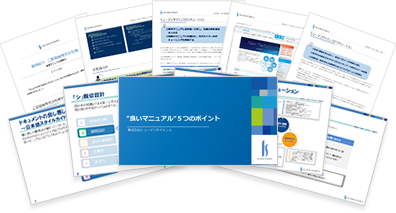Key to Organizational Strengthening! Effective Knowledge Sharing Methods

Hello! I am K, a consultant. I am in charge of creating and improving manuals for companies in the manufacturing and pharmaceutical industries.
This time, I wrote a blog about "knowledge sharing", which has become a common topic recently. From the perspective of a manual creation company, I would like to introduce specific sharing methods and the benefits of incorporating manual creation as part of knowledge sharing.
- Table of Contents
1. Why is knowledge sharing necessary?

Knowledge sharing is the act of sharing the experiences and knowledge that individual employees possess as assets throughout the entire organization. Why is it important to put effort into this initiative?
In today's business environment, labor shortage has become a serious problem. Therefore, we must increase productivity with limited members. However, many companies seem to be struggling with the following situations.
・Multiple members making the same mistake
・Newcomers are unable to stand on their own and seniors are constantly helping them, causing the seniors' work to not progress
・Receiving a large number of inquiries from other departments every day, spending most of the day answering them
To overcome the above situation and increase productivity, efforts such as "eliminating task individualization", "streamlining new employee training", and "reducing internal inquiries" are necessary. And the key to success in these efforts lies in sharing knowledge. If knowledge is shared, the concerns mentioned earlier can be solved as follows.
・By sharing examples of mistakes among team members, it was possible to notice them before they happened.
・Because there was a manual for new employees, they only asked questions to their seniors when they couldn't understand the manual.
・By organizing manuals and FAQs, the number of inquiries decreased.
By sharing individual knowledge and converting it into organizational knowledge, it is possible to strengthen the organization and increase productivity.
2. Implicit Knowledge, Explicit Knowledge, and the SECI Model

Before introducing the methods of knowledge sharing, I would like to touch upon the essential concepts of "tacit knowledge" and "explicit knowledge" as well as the "SECI model" when discussing knowledge sharing.
According to Japanese management scholar Ikujiro Nonaka, organizations have two types of knowledge: "tacit knowledge" and "explicit knowledge".
"Tacit knowledge" is knowledge that is difficult to express, based on individual actions, values, and intuition, while "explicit knowledge" is knowledge that can be objectively understood, expressed in words or diagrams.
By converting and sharing tacit knowledge into explicit knowledge, individual knowledge becomes organizational knowledge, and the organization as a whole evolves intellectually.
And the transition from tacit knowledge to explicit knowledge is carried out based on a framework called the "SECI model".
The SECI model consists of four phases: "externalization", "combination", "internalization", and "socialization". It is said that by transforming tacit knowledge and explicit knowledge according to these phases, higher level and new knowledge can be created.
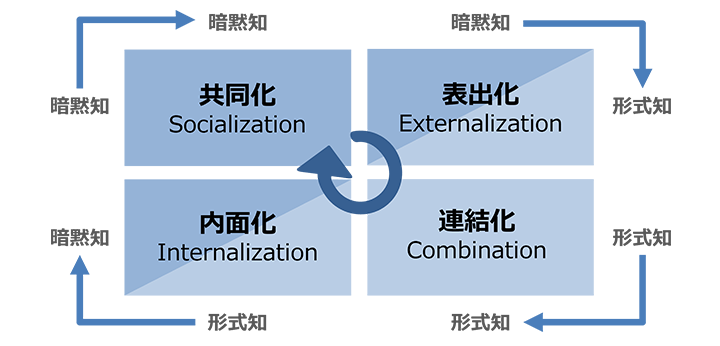
The specialty of Human Science is "expression", but in order to understand its position, first we will explain the entire model.
1. Socialization: Conversion from individual "tacit knowledge" to organizational "tacit knowledge"
This is the phase where an individual's tacit knowledge is shared with others through sharing experiences and senses. For example, direct communication and knowledge sharing through experiences such as an apprentice learning by watching a craftsman work.
2. Externalization: Conversion from "tacit knowledge" to "explicit knowledge"
This is the phase where individual tacit knowledge is objectively verbalized and quantified through dialogue, words, and figures. For example, activities such as summarizing knowledge based on experience into procedures and manuals fall under this category.
3. Combination: Conversion from existing "formal knowledge" to new "formal knowledge"
This is the phase where existing knowledge is combined or reorganized to create new knowledge. For example, sharing a manual created by someone with team members and having them add tips would fall under this category.
4. Internalization: Conversion from "explicit knowledge" to "tacit knowledge"
This is the phase of incorporating tacit knowledge through practice and experience. For example, reading manuals and documents and utilizing them in practical work corresponds to acquiring new insights and knowledge.
By following the SECI model, knowledge can be converted from individual to organizational. As mentioned earlier, if knowledge is shared within the organization, it will lead to strengthening of organizational capabilities and improvement of productivity.
This is a blog about "knowledge sharing from the perspective of a manual creation company", so I would like to focus on the "externalization" phase of the SECI model and introduce specific methods.
3. Specific Methods for Knowledge Sharing (Expression Phase)

Now, let's introduce the method of externalization, which is a specific way to share knowledge in an objective visible form.
・Holding regular meetings and study sessions
By verbalizing the knowledge and information that team members possess during meetings, it is possible to share knowledge.
There are benefits such as being able to obtain the latest information in real time and enhancing the sense of unity among team members through communication. However, in order to avoid becoming a casual conversation, it is necessary for members to participate with a common sense of purpose.
・Building a knowledge base such as an internal Wiki or FAQ
By documenting the knowledge and information held by team members and centrally managing it in a location accessible to other members, knowledge can be shared.
This allows for quick searching and referencing of information, making it possible to efficiently acquire knowledge. However, regular maintenance is necessary as information can become outdated and no longer used.
- Creating Manuals
By documenting the work procedures and know-how in the minds of some members, knowledge can be shared.
Having a manual allows for maintaining a certain level of quality even when the same work is performed by different people. Additionally, creating a manual for new members can shorten the time it takes for them to get up and running. However, just like a knowledge base, regular maintenance is necessary. In particular, when the work procedures or systems used for the job change, the manual must also be updated.
In the following chapter, we will explain the key points for creating effective manuals with a focus on manual creation for knowledge sharing.
4. Points for Creating Manuals for Knowledge Sharing

Manuals for knowledge sharing are created to share one's own knowledge with others. Therefore, it is meaningless to create something that is "unreadable" or "uninteresting".
To create a usable manual, there are several key points to keep in mind. Here, we will introduce three typical ones.
- Clarify the purpose and target of the manual
Please open the manual that you often use. Does the manual state when and for what purpose it is used (objective), and who it is intended for (target)?
If the purpose and target are not written, the reader will wonder, "When should I use this manual?" or "Is the information I need right here?" And then, they may end up saying, "I read through it, but I still couldn't find the information I needed." This will only waste time in finding the necessary knowledge. It may even lead to the feeling of "Even if there is a manual, it's useless."
To make it a manual that can be used, it is good to have a chapter called "Introduction" and specify who the manual is for. If you have never written about the purpose or target, please read the following blog. It explains the basic points related to manual creation.
What are the steps for creating a manual? Explanation of tips and key points
- Make manuals easy to read and understand
Have you ever opened a manual and thought, "This is so difficult to read..."?
Without pictures or illustrations, and with long sentences, it can be exhausting just to read through. Especially when manuals are written in the midst of a busy schedule, they often end up being filled with information that is difficult for the reader to understand.
In order to create a manual that can be used, it is necessary to summarize it concisely while giving a clear layout.
If you want to know techniques for writing easy-to-read and understandable manuals, please read the following blog. We introduce points to make the reader want to read and try it out.
[Explanation from On-site Personnel!] 3 Key Points for Creating an Easy-to-Read Operations Manual
The Importance of Formatting in Manual Creation ~From the Perspectives of the Reader and Writer~
- Make it easy to create/update manuals and manage them
If it takes too long to create/update manuals, they will be put off and knowledge sharing will not progress.
Also, if the location of the manuals is not determined and the situation is "I don't know where the manuals are", or if they cannot be searched from servers or internal systems, the manuals will not be used even if they are created.
In order to establish a manual, it is also important to create an environment that is easy to create, update, and manage.
It is convenient to prepare a template for the manual and incorporate formats and icons into it. If you cannot secure time to create a template, it is also effective to introduce external tools.
Human Science Co., Ltd. can also collaborate with companies that provide manual creation/management tools to introduce the perfect tools and platforms for our customers. If you are interested in implementing these tools, please join the joint seminar hosted by Human Science Co., Ltd. and the tool provider company.
5. Consult Human Science for Manual Creation
Human Science provides one-stop support for everything from creating Japanese manuals to translating them into English. We have a proven track record of handling numerous manuals since 1985.
If you have any of the following needs, please feel free to consult with us.
・Want to improve existing Japanese or English manuals to make them easier to understand
・Considering creating an English manual and want to proceed step by step from a Japanese manual
・Want to utilize internally created Japanese manuals by translating them into English
Features ①: Extensive track record of manual production for large and global companies
Human Science has accumulated a track record of manual creation in various fields, mainly in the manufacturing and IT industries. So far, DOCOMO Technology, Inc.Yahoo Japan CorporationYamaha Corporation and other well-known companies have been our clients.
Manual Creation Case Study Introduction | Human Science Co., Ltd.
Feature 2: From research and analysis to output by experienced consultants
Our experienced consultants at Human Science will be involved in creating business manuals. Our skilled consultants will propose easy-to-understand and effective manuals based on their extensive experience and provided materials. We also offer manual creation from the early stages of unorganized information. Our assigned consultants will conduct interviews and create the most suitable manual for your needs.
Manual Evaluation, Analysis, and Improvement Proposal Service | Human Science Co., Ltd.
Feature 3: Not only manualization, but also emphasis on support for establishment
Human Science Co., Ltd. not only creates manuals, but also focuses on the important stage of "institutionalization". Even after creating manuals, we will support the establishment of manuals through regular updates and manual creation seminars. We will support the effective use of manuals in the field through various measures.
Manual Creation Seminar | Human Science Co., Ltd.
Thank you for reading until the end.
I hope this blog can be a helpful tip for creating easy-to-understand manuals.
Related Services
◎Business Manual Creation
◎Operation Manual Creation
◎ Manual Evaluation, Analysis, and Improvement Proposal Service
◎One-stop service for manual creation and translation
Manual and Instruction Manual Translation Service | Human Science (science.co.jp)
Tips for creating and establishing business manuals taught by professionals
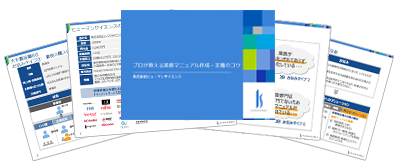


























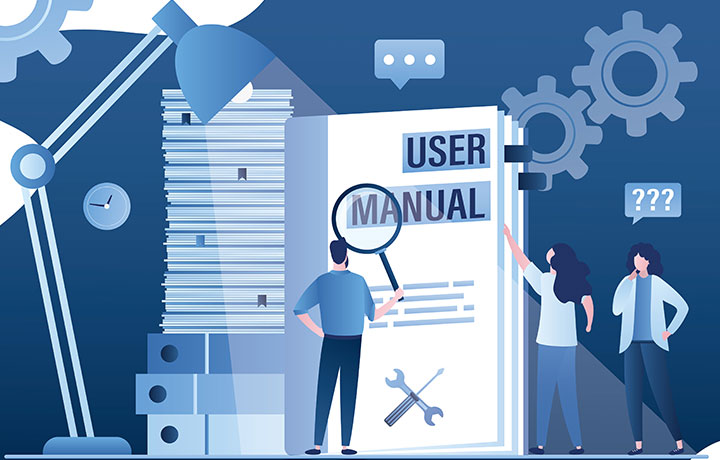









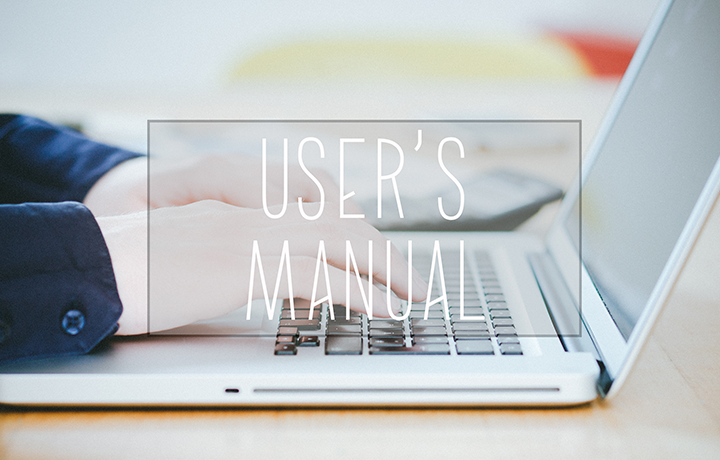











 Manual Creation
Manual Creation Director, Writer
Director, Writer In-house support
In-house support Video
Video Manual
Manual Manual Creation
Manual Creation Manual Creation
Manual Creation Manual Documentation
Manual Documentation